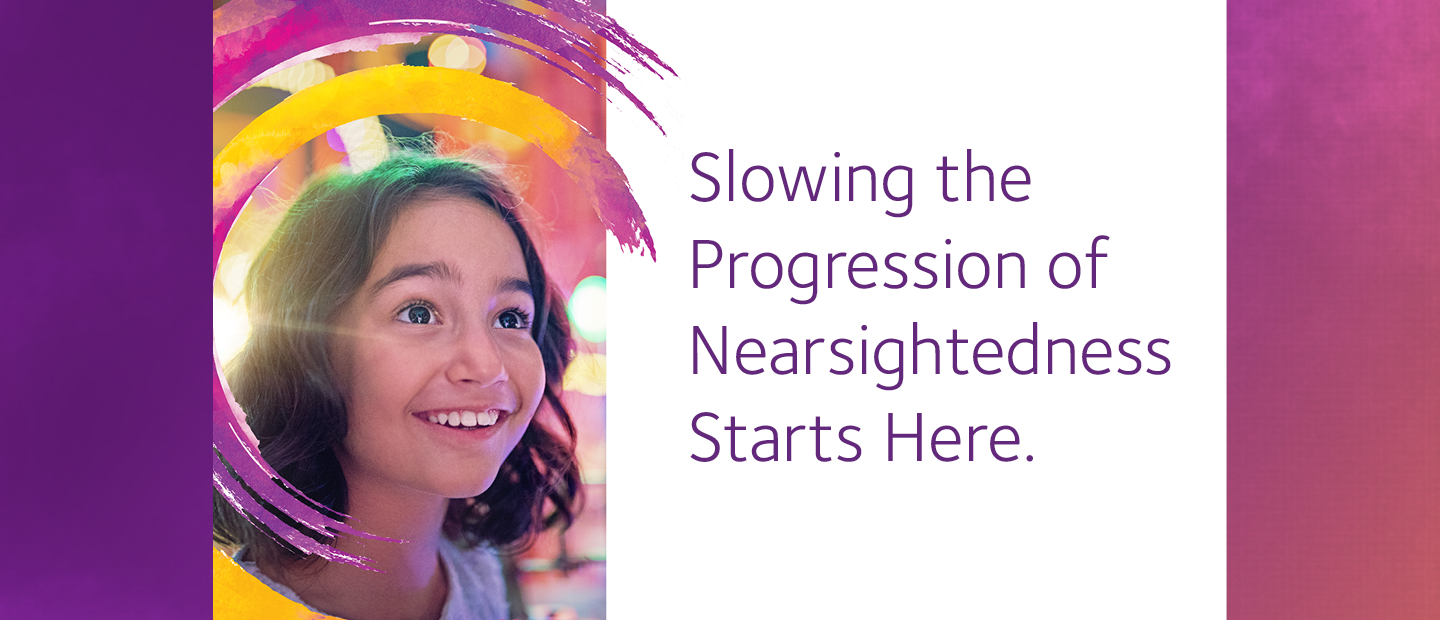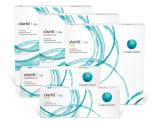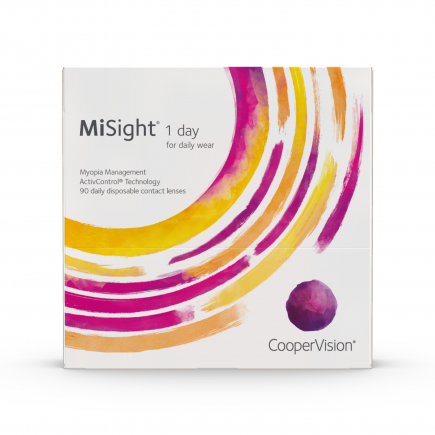
The Brilliant Futures™ Myopia Management Program, with MiSight® 1 day contact lenses,
can help age-appropriate children with Myopia reach their full potential.

The world through a child’s eyes is beautiful.
Don’t let nearsightedness take it away.
Nearsightedness is actually Myopia, a serious medical condition, that can lead to long-term eye health problems.
Acting now will set your child up with the successful future they deserve. Whether or not your child complains of not being able to see objects at a distance—such as the board at the front of their classroom— they might have a condition called myopia.
The eyes of a child with myopia become longer over time, which causes distant objects to appear blurry. And, if it’s not addressed, myopia often worsens as your child gets older.
MiSight® 1 day contact lenses are the first and ONLY soft contact lenses that are
FDA approved* to slow the progression of myopia in children
8-12 years of age at initiation of treatment2†.
Myopia management today could mean less worry tomorrow
If you’ve happily worn glasses or contacts all your life, it might seem excessive to start managing myopia in children as young as eight years of age. However, worsening myopia may contribute to more severe eye health complications and sight-threatening conditions later in life, including:1,3-5
Retinal detachment:
A condition that occurs when the retina, a thin layer of tissue that surrounds the inside of the eye, pulls away from supportive layers of blood vessels that provide its necessary oxygen and nourishment.11
Myopic maculopathy:
A condition caused by the deterioration of the central portion of the retina, and is a leading cause of severe, irreversible vision loss.12
Glaucoma:
A condition, usually linked to pressure inside the eye, that causes damage to the eye’s optic nerve, potentially causing irreversible vision loss and blindness. Studies show people with myopia have a 2-3x greater risk of developing glaucoma.13
Cataracts:
A clouding of the lens of the eye that can cause changes in vision. Though cataracts can affect everyone as they age, they often develop sooner in patients with myopia.14
What causes myopia?
Myopia is on the rise - in it's frequency and severity6. The reason for it's escalation has been linked to two factors.
Genetics
Family history plays a role in your child’s risk of myopia. The likelihood of children developing increases if their parents are myopic.7
The odds of a child becoming myopic are approximately:7
when both parents are myopic
when one parent is myopic
when neither parent is myopic
Lifestyles
Research shows that modern lifestyles may influence the development of myopia.7,9


What Does Myopia Look Like?
If you’re wondering what myopia looks like through your child’s eyes, find out by using our Myopia Simulator
See the world through your child’s eyes. Experience the Myopia Simulator.

Brilliant Futures™ Myopia Management Program
Managing your child’s myopia—both today and in the future—requires more than just vision correction. The Brilliant Futures™ Myopia Management Program with MiSight® 1 day contact lenses provides you with:
And confidence you need throughout your child’s clinical treatment to optimize clinical outcomes today and in the future.
At CooperVision, we have a history of developing proven solutions for many of the toughest vision challenges—including childhood myopia. And, today, we’re leading the way in helping children like yours see better today and in the future.
Our innovative technologies and products—including MiSight® 1 day contact lenses—are making a diference. And our Brilliant Futures™ Myopia Management Program is just one more step we’re taking in setting a new standard of care for treating myopia in children.
Through the support provided by CooperVision’s Brilliant Futures™ Myopia Management Program, you can help your child live their best and brightest future. Ask your Brilliant Futures™ Myopia Management Program-certified eye care professional about how you can get started.
The journey toward a brighter future starts today.

Start managing your child’s myopia today
- The First and Only. MiSight® 1 day is the first and only FDA-approved* soft contact lens to slow the progression of myopia in children aged 8 -12 at the initiation of treatment2†.
- Clinically Proven and Safe. Over a 3-year period, slowed myopia progression 59% on average, reduced eye lengthening by 52% on average2†§, and 41% of eyes had no progression2†¶. Over a 6-year period, children wearing MiSight 1 day progressed less than 1.00D on average11§.
- Parent-Approved. 90% of parents whose children wore MiSight® 1 day contact lenses reported that their children were happy wearing MiSight® 1 day lenses12|.
- Child Friendly. After using MiSight® 1 day contact lenses for three years, 90% of children still strongly preferred them over their glasses13.


FDA-approved
MiSight® 1 day contact lenses are FDA-approved* to slow the progression of myopia in children 8 to 12 years of age at initiation of treatment2†. That means that they’ve been comprehensively tested over an extended period and have met all of the safety criteria required by the Food and Drug Administration (FDA).
Clinical Data
The testing of MiSight® 1 day lenses consisted of a three-year clinical study in children 8-12 years old at the time they began treatment for myopia. Half of these children wore MiSight® 1 day contact lenses and the other half wore traditional 1 day soft contact lenses. This way, we could see if MiSight® 1 day really made a difference. And they did. The progression of myopia slowed in 41% of children who wore MiSight® 1 day contact lenses as compared to those who didn’t2¶.

For consumer care call: 1-855-526-6737
____________________________________________________________________________________________________________________________________________________________________________________________________________________________________________________________________________________________________________________________________________
*USA Indications for use: MiSight® 1 day (omafilcon A) soft (hydrophilic) contact lenses for daily wear are indicated for the correction of myopic ametropia and for slowing the progression of myopia in children with non-diseased eyes, who at the initiation of treatment are 8-12 years of age and have a refraction of -0.75 to -4.00 diopters (spherical equivalent) with ≤ 0.75 diopters of astigmatism. The lens is to be discarded after each removal. Canadian Indications for use: MiSight (omafilcon A) Soft Contact Lenses for Myopia Control may reduce the rate of myopia progression in children (6-18) and correct ametropia. Reduction of myopia progression was observed in children with wearing time of 12 hours (8-16 hours) per day, 6.4 days (5-7) per week in a clinical study. Permanent myopia control after lens treatment is discontinued is not supported by clinical studies. MiSight (omafilcon A) Soft Contact Lenses for Myopia Control are indicated for single use daily disposable wear. When prescribed for daily disposable wear, the lens is to be discarded after each removal.
†Compared to a single vision 1 day lens over a 3 year period. §Children aged 8-12 at the initiation of treatment.
¶No clinically meaningful change in refractive error -0.25D or less from baseline.
|Overall experience as defined as children's comfort, vision, lens handling, and freedom from spectacles. Children aged 8-15 years.
References:
1. Flitcroft DI. The complex interactions of retinal, optical, and environmental factors in myopia aetiology Prog Retin Eye Res. 2012;31(6):622-660.
2. Chamberlain P, et al. A 3-year randomized clinical trial of MiSight® lenses for myopia control. Optom Vis Sci. 2019; 96(8):556-567.
3. Chen SJ, et al. Prevalence and associated risk factors of myopic maculopathy in elderly Chinese: the Shihpai eye study. Invest Ophthalmol Vis Sci. 2012;53(8):4868-4873.
4. Chen SJ, et al. High myopia as a risk factor in primary open angle glaucoma. Int J Ophthalmol. 2012; 5(6):750-753.
5. Younan C, et al. Myopia and incident cataract and cataract surgery: the blue mountains eye study. Invest Ophthalmol Vis Sci. 2002;43(3625-3632.
6. Holden BA, et al. Global Prevalence of Myopia and High Myopia and Temporal Trends from 2000 through 2050. Ophthalmology. 2016;123(5):1036-42.
7. Morgan P. Is Myopia Control the Next Contact Lens Revolution? OPTICIAN 2016
8. Gifford P, Gifford, K L. The Future of Myopia Control Contact Lenses. Opt Vis Sci. 2016;93(4):336-43.
9. Rose KA, Morgan IG, Ip J, et al. Outdoor Activity Reduces the Prevalence of Myopia in Children. Ophthalmology 2008;115(8):1279-85.
10. Wolffsohn JS, Calossi A, Cho P, et al. Global Trends in Myopia Management Attitudes and Strategies in ClinicalPractice. Cont Lens Anterior Eye. 2016;39(2):106-16.
11. Chamberlain P, Arumugam B, Jones D et al. Myopia Progression in Children wearing Dual-Focus Contact Lenses: 6-year findings. Optom Vis Sci 2020;97(E-abstract): 200038.
12. CVI data on file 2018. 3- year study report.
13. Sulley A et al. Wearer experience and subjective responses with dual focus compared to spherical, single vision soft contact lenses in children during a 3-year clinical trial. AAO 2019 Poster Presentation.







